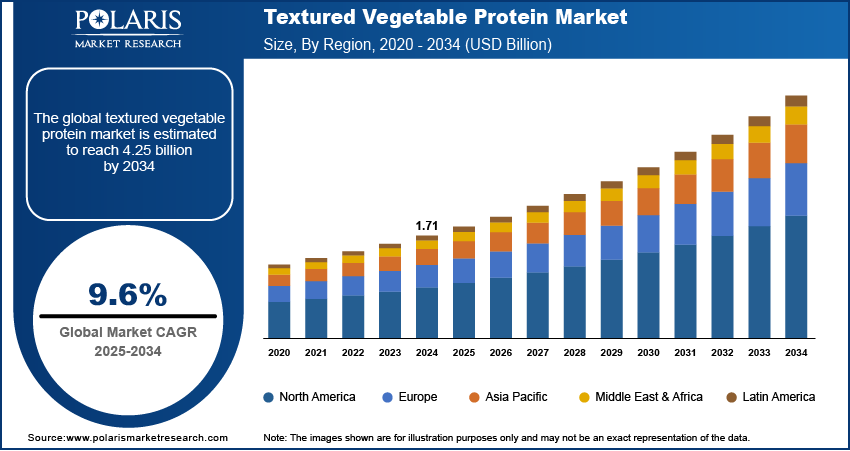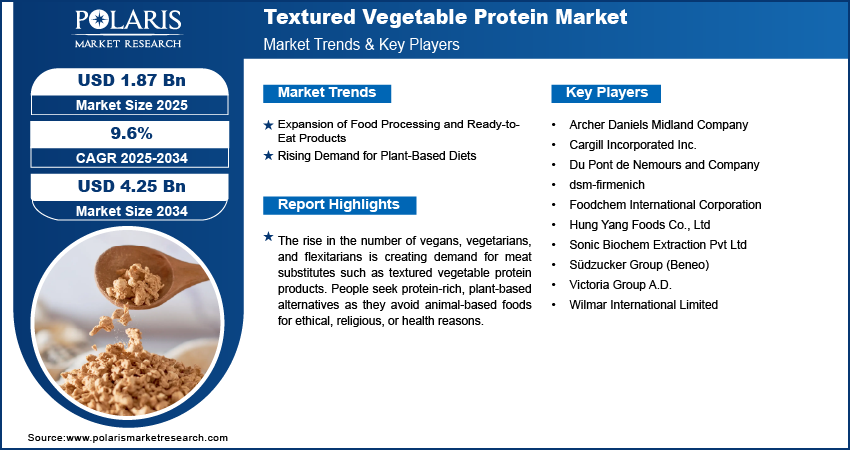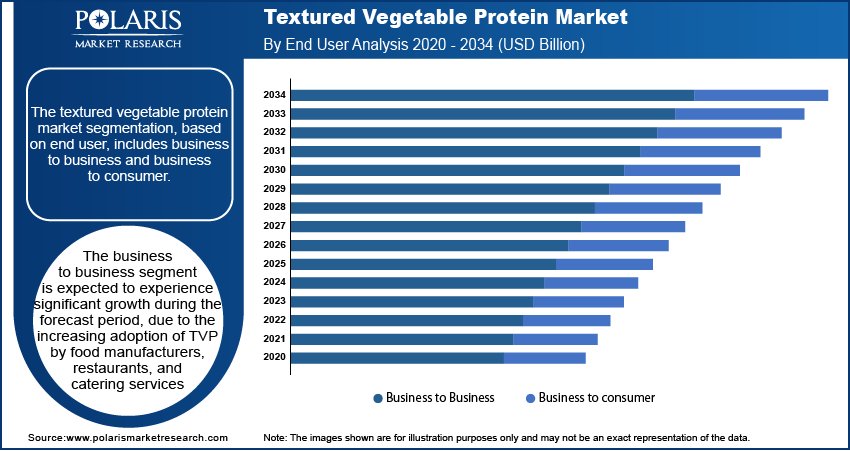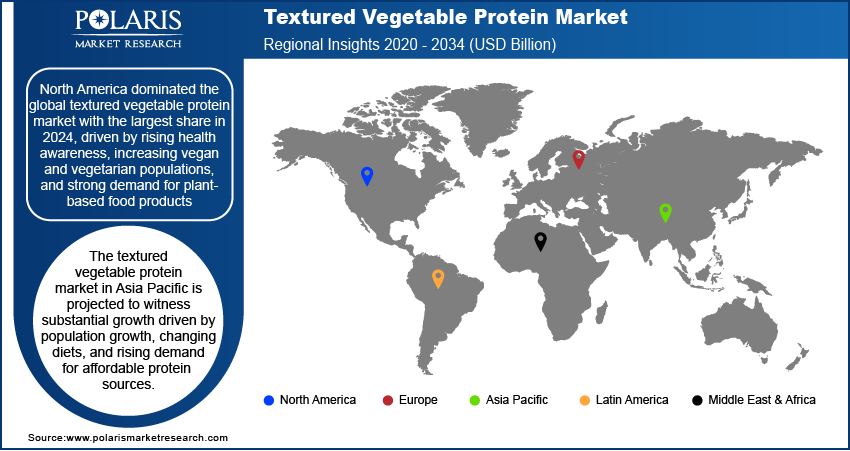
Textured Vegetable Protein Market Size, Share, Trends, Industry Analysis Report
By Product Type (Textured Soy Protein, Others), By Form, By End User, By Region – Market Forecast, 2025–2034
- Published Date:Jul-2025
- Pages: 129
- Format: PDF
- Report ID: PM6074
- Base Year: 2024
- Historical Data: 2020-2023
Overview
The global textured vegetable protein (TVP) market size was valued at USD 1.71 billion in 2024, growing at a CAGR of 9.6% from 2025 to 2034. The market growth is driven by the expansion of food processing and ready-to-eat products and rising demand for plant-based diets.
Key Insights
- In 2024, the textured soy protein segment dominated with the largest share due to its wide availability, cost-effectiveness, and high protein content.
- The business to business segment is expected to experience significant growth during the forecast period due to the increasing adoption of TVP by food manufacturers, restaurants, and catering services.
- North America dominated the market with the largest share in 2024, driven by rising health awareness, increasing vegan and vegetarian populations, and strong demand for plant-based food products.
- The industry in the U.S. is expected to witness significant growth during the forecast period, due to its strong consumer base for plant-based foods and the advanced food processing industry.
- The textured vegetable protein market in Asia Pacific is projected to witness substantial growth during 2025–2034 driven by population growth, changing diet, and rising demand for affordable protein sources
Industry Dynamics
- Expansion of food processing and ready-to-eat products is driving the demand for textured vegetable proteins.
- Rising demand for plant-based diets is fueling the industry growth.
- The rise in the number of vegans, vegetarians, and flexitarians is creating more demand for meat substitutes such as textured vegetable protein.
- High processing costs and potential allergens, especially from soy-based products, restrain the TVP market expansion.
Market Statistics
- 2024 Market Size: USD 1.71 billion
- 2034 Projected Market Size: USD 4.25 Billion
- CAGR (2025–2034): 9.6%
- North America: Largest market in 2024

To Understand More About this Research: Request a Free Sample Report
Textured vegetable protein (TVP) is a plant-based meat alternative made by extracting protein from soy, peas, or other vegetables and then processing it into granules, chunks, or strips. It is high in protein, low in fat, and often used in vegetarian or vegan recipes. TVP absorbs flavors well and mimics the texture of meat when rehydrated, making it popular in various dishes such as tacos, burgers, and chili.
TVP is a rich source of protein, fiber, and essential nutrients while being low in fat and cholesterol-free. These nutritional benefits make it an attractive option for health-focused consumers. It helps in weight management, heart health, and maintaining balanced diets, especially for people avoiding animal proteins. Many are turning to healthier food choices such as TVP as awareness about chronic diseases such as obesity and cardiovascular issues rises. Food manufacturers further promote these benefits on product packaging, influencing more buyers. Thus, TVP’s nutritional value directly supports its growing popularity in various health-conscious regions worldwide, thereby driving the growth.
The rise in the number of vegans, vegetarians, and flexitarians is creating more demand for meat substitutes such as textured vegetable protein. People seek protein-rich, plant-based alternatives as they avoid animal-based foods for ethical, religious, or health reasons. TVP meets these needs while offering a texture and taste similar to meat when cooked. Food companies are increasingly launching products that use TVP, such as veggie burgers, meatless sausages, and vegan ready meals. This shift in dietary preferences across many countries is fueling the growth.
Drivers and Trends
Expansion of Food Processing and Ready-to-Eat Products: The rapid development of the food processing industry and the rising demand for convenient, ready-to-eat products have significantly fueled the use of textured vegetable with high protein. According to the U.S. Bureau of Labor Statistics, in the U.S. alone, 63,970 people are employed in the food processing industry. TVP is widely used in pre-packaged meals, frozen foods, and snack products due to its long shelf life and easy preparation. Additionally, Busy lifestyles and urbanization are pushing consumers toward fast, healthy meal options, where this product fits perfectly. Manufacturers are using TVP to create innovative food products that cater to modern consumers' needs. This growing segment expands the use of TVP in different cuisines and makes it more accessible in supermarkets and food outlets, thereby driving the growth.
Rising Demand for Plant-Based Diets: The growing popularity of plant-based diets is driving the TVP demand. The demand for meat alternatives is rising as more people become health-conscious or follow vegan and vegetarian lifestyles. TVP, made from soy or other plant proteins, offers a low-fat, high-protein substitute for meat. It appeals to consumers seeking to reduce animal product consumption for ethical, environmental, or health reasons. The plant-based food trend is especially strong among millennials and Gen Z, further boosting the growth.

Segmental Insights
Product Type Analysis
The segmentation, based on product type, includes textured soy protein and others. In 2024, the textured soy protein segment dominated with the largest share due to its wide availability, cost-effectiveness, and high protein content. It is one of the most established forms of TVP, used extensively in processed foods, meat alternatives, and ready meals. Soy protein is popular among manufacturers for its meat-like texture, easy absorption of flavors, and proven performance in food processing. Its long-standing presence and consumer familiarity make it the preferred choice. Additionally, it aligns with vegetarian and vegan dietary needs, further boosting its popularity across both developed and developing regions, thereby driving the segment growth.
Form Analysis
Based on form, the segmentation includes granules, flakes, chunks, and others. In 2024, the chunks segment dominated with the largest share due to its meat-like texture and suitability for various food applications. Chunks are used in stews, stir-fries, curries, and meat substitute dishes as they closely mimic the bite and feel of real meat. This form appeals to both vegetarians and flexitarians seeking familiar meal experiences without animal products. Chunks are further popular among food service providers and households for their versatility, shelf stability, and ease of preparation, thereby driving the growth.
The granule segment is expected to experience significant growth during the forecast period due to its adaptability in food processing and growing demand for plant-based ready meals. Granules are smaller in size and ideal for blending into sauces, taco fillings, patties, and snacks. They are preferred by food manufacturers for their ease of handling, fast cooking time, and ability to absorb seasoning well. Granulated TVP is becoming increasingly popular in instant and packaged foods as consumers seek healthy and quick meal options. Its fine texture further appeals to younger consumers and helps manufacturers create innovative, protein-rich food products, thereby driving the segment growth.
End User Analysis
The segmentation, based on end user, includes business to business and business to consumer. The business to business segment is expected to experience significant growth during the forecast period due to increasing adoption of TVP by food manufacturers, restaurants, and catering services. Companies are incorporating TVP into a wide range of products, including plant-based meats, snacks, and meal kits. B2B customers are turning to TVP for its functionality and cost-efficiency as demand for high-protein, sustainable ingredients rises. This trend is particularly strong among food processors looking to meet the growing need for clean-label and vegetarian options, thereby driving the segment growth.

Regional Analysis
North America Textured Vegetable Protein Market Trends
North America dominated the global industry with the largest share in 2024, driven by rising health awareness, increasing vegan and vegetarian populations, and strong demand for plant-based food products. Consumers in this region are actively seeking meat substitute due to concerns about health, animal welfare, and environmental impact. The availability of a wide range of plant-based products in supermarkets and food chains fuels TVP consumption. Additionally, major food companies and startups in North America are investing heavily in product innovation and marketing, further boosting the popularity of TVP in the region.
U.S. Textured Vegetable Protein Market Insights
The market in the U.S. is expected to witness significant growth during the forecast period due to its strong consumer base for plant-based foods and the advanced food processing industry. A growing number of Americans are adopting vegan, vegetarian, or flexitarian lifestyles, pushing demand for high-protein meat substitutes such as TVP. The U.S. has a vibrant plant-based food industry, with many companies using TVP in products such as burgers, sausages, and ready meals. Additionally, health-conscious trends and support for sustainable eating are encouraging more people to choose TVP over traditional meat. Moreover, government initiatives and food labeling laws further support the adoption of plant-based products, thereby driving the growth.
Asia Pacific Textured Vegetable Protein Market Analysis
The market in Asia Pacific is projected witness substantial growth during the forecast period driven by population growth, changing diets, and rising demand for affordable protein sources. The demand for this product is increasing as more consumers in countries such as India, Japan, and South Korea adopt healthier eating habits. Traditional vegetarian diets and low meat consumption in cultures further support the adoption of plant-based proteins. Additionally, local manufacturers are expanding their production capacity to meet regional demand. The growing awareness of health and environmental issues further fuels the growth in the region.

China Textured Vegetable Protein Market Assessment
The industry in China is expected to experience significant growth driven by a shift in consumer preferences toward plant-based foods and the country’s focus on food security. Many Chinese consumers are turning to plant-based diets with concerns about meat safety and rising health awareness. The government is further encouraging reduced meat consumption through sustainability goals. Additionally, Chinese food companies are rapidly developing and launching plant-based products using TVP, including meat alternatives, snacks, and traditional dishes. The demand for nutritious and affordable protein options such as TVP is expected to surge as the middle class grows and urbanization increases, thereby driving the growth.
Europe Textured Vegetable Protein Market Analysis
The market in Europe is expected to experience significant growth in the coming years, driven by rising demand for sustainable and plant-based food solutions. Consumers across the region are increasingly opting for vegetarian and vegan diets due to health, ethical, and environmental reasons. The European Union’s focus on reducing carbon emissions and promoting sustainable agriculture further supports the shift toward plant-based proteins. Food manufacturers are innovating with textured vegetable protein-based products, especially in Western Europe, where clean-label and organic trends are prominent. Moreover, the strong retail support and increasing awareness are further fueling the growth.
Germany Textured Vegetable Protein Market Overview
The market in Germany is expected to experience significant growth in the coming years, as Germany is one of the leading countries in Europe when it comes to plant-based food adoption. German consumers are highly health-conscious and environmentally aware, which drives the demand for sustainable meat alternatives. Textured vegetable protein is widely used in various vegan and vegetarian products available in both supermarkets and restaurants. The country has a thriving vegan food culture, supported by active innovation from local and international brands. Additionally, government and consumer support for climate-friendly diets boosts usage, thereby driving the growth.
Key Players and Competitive Analysis
The textured vegetable protein industry is moderately consolidated, with key players focusing on product innovation, capacity expansion, and global distribution strategies. Major companies such as Archer Daniels Midland Company and Cargill Incorporated Inc. have established strong global supply chains and offer a wide range of soy-based protein products. Du Pont de Nemours and Company is known for its plant-based ingredient solutions backed by R&D capabilities. Asian manufacturers such as Hung Yang Foods Co., Ltd and Sonic Biochem Extraction Pvt Ltd contribute significantly to regional supply, especially in developing markets. Foodchem International Corporation maintains a robust portfolio in food additives, including TVP. Südzucker Group (Beneo) and Victoria Group A.D. cater to the European market with an emphasis on clean-label and sustainable protein sources. Wilmar International Limited has also entered the plant-protein segment, leveraging its established food processing infrastructure. Competitive dynamics are shaped by quality standards, pricing, and adherence to food safety regulations.
Key Players
- Archer Daniels Midland Company
- Cargill Incorporated Inc.
- Du Pont de Nemours and Company
- dsm-firmenich
- Foodchem International Corporation
- Hung Yang Foods Co., Ltd
- Sonic Biochem Extraction Pvt Ltd
- Südzucker Group (Beneo)
- Victoria Group A.D.
- Wilmar International Limited
Industry Developments
In December 2022, DSM launched the world’s first soy-free, gluten-free, and complete textured vegetable protein, Vertis Textured Pea Canola Protein. It enables manufacturers to develop nutritious, meat-like, allergen-free plant-based alternatives with improved texture and processing efficiency.
Textured Vegetable Protein Market Segmentation
By Product Type Outlook (Revenue, USD Billion, 2020–2034)
- Textured Soy Protein
- Others
By Form Outlook (Revenue, USD Billion, 2020–2034)
- Granules
- Flakes
- Chunks
- Others
By End User Outlook (Revenue, USD Billion, 2020–2034)
- Business to Business
- Business to Consumer
By Regional Outlook (Revenue, USD Billion, 2020–2034)
- North America
- U.S.
- Canada
- Mexico
- Europe
- Germany
- France
- UK
- Italy
- Spain
- Netherlands
- Russia
- Rest of Europe
- Asia Pacific
- China
- Japan
- India
- Malaysia
- South Korea
- Indonesia
- Australia
- Vietnam
- Rest of Asia Pacific
- Middle East & Africa
- Saudi Arabia
- UAE
- Israel
- South Africa
- Rest of Middle East & Africa
- Latin America
- Brazil
- Argentina
- Rest of Latin America
Textured Vegetable Protein Market Report Scope
|
Report Attributes |
Details |
|
Market Size in 2024 |
USD 1.71 Billion |
|
Market Size in 2025 |
USD 1.87 Billion |
|
Revenue Forecast by 2034 |
USD 4.25 Billion |
|
CAGR |
9.6% from 2025 to 2034 |
|
Base Year |
2024 |
|
Historical Data |
2020–2023 |
|
Forecast Period |
2025–2034 |
|
Quantitative Units |
Revenue in USD Billion and CAGR from 2025 to 2034 |
|
Report Coverage |
Revenue Forecast, Competitive Landscape, Growth Factors, and Industry Trends |
|
Segments Covered |
|
|
Regional Scope |
|
|
Competitive Landscape |
|
|
Report Format |
|
|
Customization |
Report customization as per your requirements with respect to countries, regions, and segmentation. |
FAQ's
The global market size was valued at USD 1.71 billion in 2024 and is projected to grow to USD 4.25 billion by 2034.
The global market is projected to register a CAGR of 9.6% during the forecast period.
North America dominated the market share in 2024.
A few of the key players in the market are Archer Daniels Midland Company; Cargill Incorporated Inc.; Du Pont de Nemours and Company; dsm-firmenich; Foodchem International Corporation; Hung Yang Foods Co., Ltd; Sonic Biochem Extraction Pvt Ltd; Südzucker Group (Beneo); Victoria Group A.D.; and Wilmar International Limited.
The soy textured protein dominated the market share in 2024.
The business-to-business segment is expected to witness the significant growth during the forecast period.
